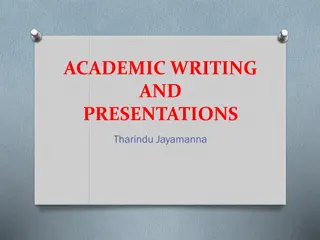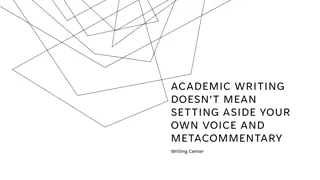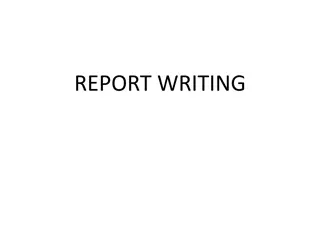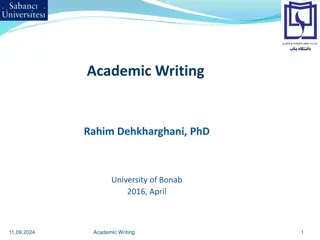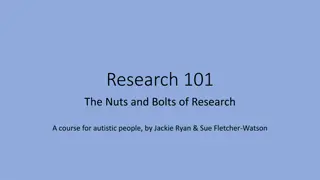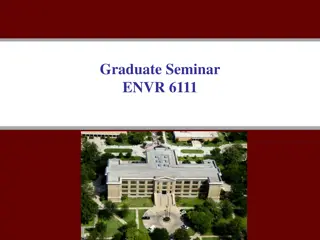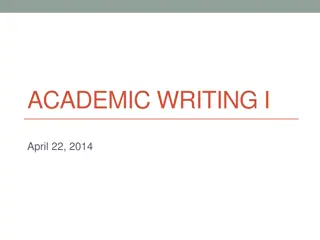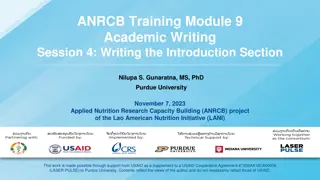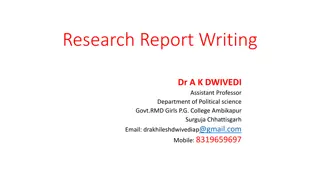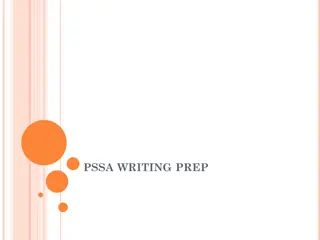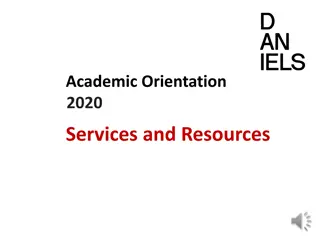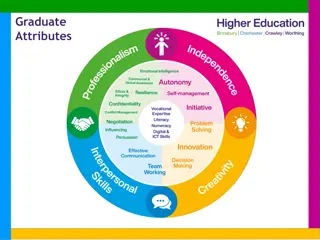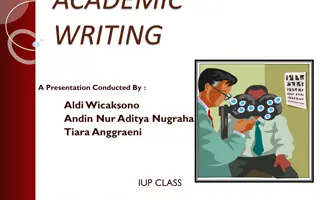Demystifying the Research and Writing Process for Academic Success
Research is a valuable tool that enhances arguments, validates ideas, and uncovers new knowledge. This process involves identifying a topic of interest, narrowing it down, conducting thorough research using primary and secondary sources, and integrating findings to form a coherent paper. By following structured steps, writers can create engaging and informative research papers that meet academic standards.
Download Presentation

Please find below an Image/Link to download the presentation.
The content on the website is provided AS IS for your information and personal use only. It may not be sold, licensed, or shared on other websites without obtaining consent from the author. Download presentation by click this link. If you encounter any issues during the download, it is possible that the publisher has removed the file from their server.
E N D
Presentation Transcript
MISPERCEPTION THAT WRITING A RESEARCH PAPER IS A TEDIOUS AND UNNECESSARY PROCESS REQUIRED ONLY BY THE ENGLISH DEPARTMENT.
Research is used to strengthen an argument, to demonstrate the need for change , to provide additional information and verification, to trace a pattern or trend, to validate ideas, to discover a process or a remedy, or to add spice to an otherwise unpersuasive piece of writing.
Depending on the topic, research may include interviews and observations, surveys, and questionnaires; the PRIMARY SOURCES are the sources that may involve reading novels, conducting experiments, or examining historical documents such as letters and original manuscripts. Primary sources can be supplemented by SECONDARY SOURCES such as analyses, assessments, and evaluations of primary sources.
Research and composing process 1. Zero in on a topic and identify what you know and what interests you about it, brainstorm, freewrite, list, cluster, or explore ideas in your journal. 2. If the topic seems quite broad, consider how you might narrow it to fit the required length and type of paper and the audience. 3. Key dates, people, places, and definitions, it may be helpful to check dictionaries.
Research and composing process 4. In this point, you may have a preliminary thesis. Keep in mind that they are only tentative until you have confirmed that they are appropriate from the information you gather. 5. Be prepared to adjust your thesis or even to abandon it in favour of another if your research suggests that you are on the wrong way. 6. Before you begin your first draft, review your notes and consider the methods of development and the organization of your paper.
Research and composing process 8. Integrate the relevant summaries, paraphrase, and quotations from your notes, and make sure you have complete and accurate documentation for all of them. 9. Purpose, thesis and audience. 10. To avoid plagiarism, make sure that every summary, paraphrase, and quotation has an in-text citation and that each citation has a corresponding entry in the works cited list. 11. Finally, proofread your paper for typos and correct formatting.
The Research Writer's Responsibilities 1. To choose sources that strengthen your credibility * Don t start by randomly surfing the internet or scrolling through the library catalog; create and use specific keywords. *Use the best available information by experts in the field. *Authors who are often cited in other writings on the topic. *Use sources that are appropriate to your thesis.
The Research Writer's Responsibilities 2. Use sources appropriately and effectively paper should reflect your thinking not simply string together quotations, paraphrase, and summaries from your sources.
The research writer's responsibilities Why sources are used? * Providing specific fact as evidence for your argument *Giving examples of different points of view, and *Emphasizing a particular striking phrase, sentence, or passage.
The research writer's responsibilities Be especially careful not to overuse direct quotations.
The research writer's responsibilities A smooth way to integrate source information in your paper is with a signal phrase at the beginning, middle, or end of a direct quotation, paraphrase, or summary.
The research writer's responsibilities signal phrase introducing quotations According to Sylvia Nasar in A Beautiful Mind, An individual vulnerability to schizophrenia .lies in his genes. But psychological stresses are thought to be catalyst (188).
The research writer's responsibilities signal phrase interrupting quotations A significant number of teenage boys are now drinking five or more cans of soda every day, reports Eric schlosser in Fast Food Nation. Each can contains the equivalent of about ten teaspoons of sugar (54).
The research writer's responsibilities signal phrase introducing and parenthetical citation following paraphrase A recent issue of Smithsonian reported that Hawaii s fish are disappearing not only because of overfishing, ocean warming, and pollution but also because of aquarium collectors (Wuethrich 26-28).
The research writer's responsibilities Each source cited in your paper must be represented by an entry in the works cited list at the end of the paper.
The research writer's responsibilities 3. Plagiarism is using someone else's words, graphics, or ideas without giving credit.






